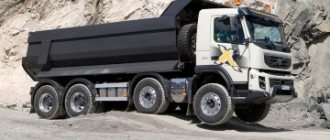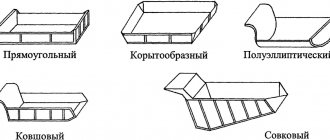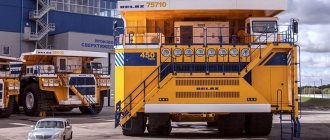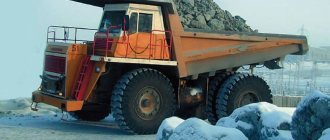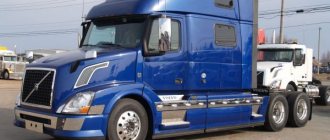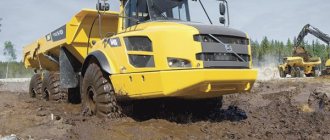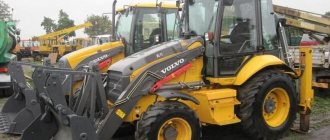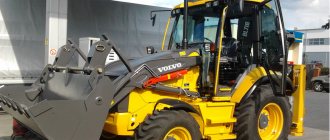Patriotism in action
Maxim Shelepenkov, photo by the author
Just a month ago I got acquainted with the Volvo FMX (6x6) dump truck, and now I have the opportunity to drive a Volvo FMX (8x4). The differences between these cars turned out to be greater than the wheel formula suggested.
About the origin
Here is a completely domestic dump truck! I'm talking not only about the Krasnogorsk dump truck superstructure, but also about the base chassis. It was also collected in Russia, in Kaluga. Of course, most of the units and chassis components were manufactured outside our homeland, but in fact, assembling it is a domestic product. In my opinion, it’s better this way than nothing. And over time, you see, we ourselves will learn to produce trucks no worse. However, I digress...
Unlike the previously reviewed all-wheel drive Volvo dump truck, this four-axle giant is equipped with a manual rather than automatic transmission. In addition, the 8x4 dump truck has the most modern dumping platform BCM-51 and is designed for continuous operation as part of a road train with a trailer with a similar dumping platform, which is also reflected in the configuration of this model. In addition, the short day cab installed on a four-axle truck gave us an unexpected surprise.
About the cabin
It is no secret that domestic operators are trying to purchase dump trucks with sleeper cabins, regardless of where and how they are going to use them. Changing life has taught us not to skimp on such things. Today you are engaged in transportation exclusively in the city, where a sleeper cab is not needed, and tomorrow your cars may take a long haul, or even have to be driven a thousand kilometers to a new place of work. In such cases, a sleeping place in the cab will give drivers the opportunity to have a good rest or spend the night in the car.
In general, these arguments are correct, if not for one “but”. A long sleeper cabin takes up half a meter of usable chassis space, which reduces the volume of the body, and most importantly, redistributes the loads along the axles. And not always for the better.
An unexpected way out of the situation was found in: a full-fledged folding berth was provided in the short day cabin. The idea itself is not new, but the implementation deserves praise. The problem with folding berths is that doing this in a small cabin is inconvenient, and this transformation takes a lot of time, since you have to move and fold the main seats at the same time. This is especially problematic when the vacation is short-term and there is a need to quickly get behind the wheel. In these cases, fiddling with folding down the sleeping shelves only irritates.
In Volvo, only that part of the shelf that is located above the passenger seat (it will still have to be folded) and above the engine compartment is thoroughly folded down and secured, and the small folding “wing” above the driver’s seat has a figured cutout for the backrest, so there is no need to move or fold it anymore necessity. Moreover, to bring the cabin into the “combat position”, just click the lock (like a seat belt) and fold the “wing” onto the main shelf - that’s it, you can take your seat behind the wheel!
All that remains is to find out whether it is comfortable to lie on a shelf with a cutout for the back of the driver's seat? We checked - it’s comfortable if you lie with your head in the opposite direction. In general, Volvo can give a solid “A” for organizing a sleeping place in a short cab, and other manufacturers should think about something similar.
Test drive the new Volvo FMX
Volvo FMX is certainly a recognized leader among its fellow builders. The new FMX was no exception, with engineers placing even more emphasis on characteristics such as reliability, handling and design. However, I'm getting ahead of myself, let's take it in order...
We were brought to the most real quarry. In such cases, it is probably customary to write: the situation was as close as possible to real conditions. Swedes, in principle, do not tend to show off; almost everything is done with a huge margin of safety. No wonder the Swedish epithet has become synonymous with quality and durability. So, the quarry in Hallered is the largest testing complex for testing construction machines in all of Northern Europe.
Before being put into production, Volvo equipment is tested here. The intensity of the tests is amazing; in a short time, the cars manage to cover a route that in real life a truck would cover in several years. IKEA store... Do you remember? A mechanism that opens and closes drawers and plops down in a chair, so the pictures are somewhat similar! Maximum loads make it possible to identify and eliminate design flaws. Components and parts are being ground in; one can say that all Volvo dump trucks undergo their baptism of fire here.
Before starting work, and there was no longer any doubt that a real work shift lay ahead of us, Volvo specialists conducted detailed safety training. To the side, cameras and voice recorders, helmets and yellow vests are our everything! Journalists, one and all, retrained as dump truck drivers.
Meanwhile, two dozen trucks were waiting for us at the site, ready to set off. Various configurations and wheel formulas were presented: 4x4, 6x4, 6x6, 8x4, 8x6. There was even a gigantic Volvo FMX 500 with a 10x4 formula and a total weight of 66 tons, this one was capable of taking up to 44 tons of rock in the back.
Volvo is amazing at planning their test runs, this is some fantastic feature of Volvo Trucks and I have never seen anything like it anywhere else. I would never have thought that this was possible in principle. In one working day I had the opportunity to drive all (20!!!) trucks presented in the test. And it’s not just a short distance from point A to point B, no, it was a full-fledged flight, or a walk, if you like.
Moreover, at first I had the opportunity to drive an empty dump truck in order to fully feel the truck, its size and the features of the wheel formula. And only then did he get to the loading point, for a portion of his crushed stone. This approach allowed me not to screw up on the climbs and, on the contrary, to add power to the engine brake on the descents in time. No surprises, so to speak, with a sense of purpose... There were only two laps, one of which was more like a standard construction track, and the second was replete with difficult sections, the so-called off-road route.
What about the car, how does the new FMX differ from its predecessor? And the first thing that catches your eye is the design; it is designed in the same corporate style of all new Volvo trucks. The cabin is made of high-strength steel and has passed all Swedish safety tests. The prominent lower cheekbone of the bumper, according to the manufacturers, will withstand a low-speed collision with an obstacle without visible consequences. However, knowing the drivers and the conditions in which the equipment operates, the bumper was made of three parts. If an emergency could not be avoided, the damaged part can be easily replaced literally in the field.
The bumper cross member is made of cast iron, and the side components are made of three-millimeter steel, and the oil pan is made of the same steel. It stretches from the bumper to the front axle, securely covering all internal parts. The design is extremely well thought out, and all the mounting bolts are located outside. Are we really going back to the past, when iron was fastened to iron! The plastic foglights, which caused a lot of criticism, disappeared from the bumper. Lens headlights also went into oblivion, and the head light was reduced into a single block headlight, hiding it behind the grille. It must be said that a lot of work was done on the light of the new Volvo FMX; as a result, the headlights were placed as high as possible above the road, minimizing the likelihood of damage.
The philosophy of the new Volvo FMX can be summed up in one simple word: toughness. And then the guys responsible for the PR campaign for the new truck took a risk and made the right decision. They simply hung their truck by a towing eye high above the sea. While the president of Volvo Trucks, Claes Nilsson, tells the audience about the strength of his brainchild, standing at a crazy height. The video hit the target; in a couple of months, about three million viewers watched it around the world.
The test FMXs were equipped with engines with a displacement of 11 and 13 liters, Euro 6 standard and power from 330 to 540 horsepower. In Russia, cars with Euro-4 and Euro-5 engines will be sold. All dump trucks were equipped with Volvo I-Shift automatic transmissions. Europe is moving away from manual control, and even construction equipment, seemingly the domain of mechanics, is losing ground. However, it is worth admitting that I-Shift allows the driver to relax and shift part of the work to the robot, rocking a stuck car is easy, all you need to do is press a button and press the gas pedal! The I-Shift box forgives mistakes and, as in my case, allows you to quickly get involved in the work process, without additional training. Smooth gear shifting reduces the load on the power drive, thereby reducing maintenance costs. Then the driver always has the opportunity to use manual shift mode.
I may digress from the topic, but not long ago I had a private conversation with the owner of a fleet of vehicles from Moscow, in which he admitted to me: “imagine, the time has come to update the rolling stock, a million kilometers, the trucks have done their job and in all this time there have been no I-Shift one serious complaint, except perhaps one that happened when selling a car - the average person refuses to believe in the incredible survivability of the unit.”
Looking at the interior of the cabin, it is worth noting that the new Volvo FMX has placed emphasis on improving the driver's working conditions. I will not focus my attention on leather and other benefits of Western civilization, although these are not empty words, because the interior of the new Volvo FMX was created from scratch and meets Volvo’s highest quality standards. The steering wheel contains buttons for controlling various functions, including cruise control, telephone and navigation system. There is a new instrument panel and information display, and to increase the space allocated for the driver's feet, the starter key socket has been moved closer to the dashboard. FMX has previously been distinguished by increased comfort; drivers did not complain about the climate in the cabin, but the Swedes found this not enough. The system has undergone changes and has become more efficient and functional when heating.
Knowing the working conditions of dump trucks in Russia, our carrier is more interested in how easily dirt and clay can be washed off from fashionable interiors and upholstery. And here Volvo is again ahead of the rest, namely: all materials and interior colors are selected taking into account work in extreme construction conditions. Moreover, this is not just hard, soulless plastic, no, materials that are soft to the touch, which can easily be restored to their original appearance with a damp cloth without fear of losing their presentation forever. Of course, I wouldn’t risk washing the entire cabin with a hose, but for the most part all those places that the driver will come into contact with dirty clothes and shoes are not afraid of moisture.
The Swedes, in my opinion, paid a lot of attention to the new Volvo Dynamic Steering option. Without going into too much detail, Volvo's patented Dynamic Steering technology is an electronically controlled electric motor attached to the steering shaft, paired with power steering. Its actions are regulated by an electronic control module several thousand times per second. The diagram is shown in the photograph. The benefits of Volvo Dynamic Steering are most noticeable when driving the car at low speeds over very rough terrain, as in the photo below.
The electric motor allows you to apply a minimum of physical effort. The driver can relax and drive the car without much stress. Regular readers of the Trucker Blog probably remember the video of an ordinary hamster driving a multi-ton colossus (link). In my opinion, this is the best illustration of how the system works. If you ask me how is it? I’ll answer - I don’t understand. One day is too little to dot all the i’s. Definitely, feedback from the road is lost. And if I go through difficult terrain, I can say with 100% certainty - it was cool. But how the car will behave on ice remains a mystery to me. However, Sweden is not Africa, and snowy winters are the same reality as in Russia, and you can be sure that the system has passed absolutely all tests.
Our attention was focused on the new rear air suspension. In itself, it is certainly not new; in this case, it was specially adapted for the off-road cargo segment. We see that all vulnerable suspension components, such as shock absorbers, stabilizers and air springs, are retracted inside and located above the axle beam. You may ask why the garden was fenced? The answer is: increased ground clearance, ground clearance up to 300 mm and, as a result, increased cross-country ability - time. Provides excellent longitudinal and lateral stability of the truck both when driving and when unloading - two. Vibrations on the body are reduced, driving comfort is improved - three.
Many drivers express skepticism about air suspension, but Volvo proves otherwise. The stabilizers are connected to the frame in the most rigid place, which gives the structure special rigidity and compactness. The absence of elements behind the bogie made it possible to make the rear overhang shorter and move the dump truck's tipping axis even closer to the rear bogie. The process of tipping the body is facilitated, the dump truck is more stable and stable when unloading. Four cushions per axle and powerful stabilizers, which can be seen in the photo, do not give even a shadow of doubt about the calculations of Volvo Trucks engineers. Air suspension is available for 4x2, 6x4 and 8x4 trucks.
In contrast to traditional four-axle 2+2 tippers, Volvo Trucks has introduced several new models with a three-axle rear bogie for comparison. An option, as in the photo, when there are two driving axles at the rear plus a third rotary and supporting one. The Swedes called this arrangement of axes “tridem”. To my surprise, even I noticed the advantages. A truck with a tridem between the first and fourth turning axles has a distance of about six meters - this is the minimum turning radius of which the car is capable. In this case, six meters will not be enough for a truck with the traditional 2+2 formula.
It is important that with this arrangement of axes, the driving ones will always be more loaded. In deteriorating road conditions, a dump truck with a tridem will always be in a better position. While going up a steep climb, I noticed that the 2+2 in front of me was prone to frequent slipping on dry loose soil, while at the same time, my three-axle cart did not give even a hint of slipping. The thing is that the air suspension has the ability to redistribute the load function along the axles, and in this case it worked automatically. My rear axle just unloaded in favor of the drive axles, that's it! Again, no one has canceled the savings on fuel and tires, because the rear axle does not work when unloaded.
It’s difficult to describe my feelings after my work shift. They are twofold, judge for yourself: on the one hand, a dump truck, heaps of rubble and a quarry, and on the other: Volvo FMX, I-Shift, Volvo Dynamic Steering and an air-cushioned tridem. I felt as if I had just taken off my sandals on the threshold of a quarry in Hallered, Sweden, or, if you prefer, as a guest worker who came to work in Western Europe. In order to unload the body, all I had to do was remove the remote control and, after a simple combination with the keys, observe a fresh pile of rubble in the rear view camera. I didn't even lift my butt off the seat.
The last time I worked professionally at a construction site, I had a ZIL 130, and I always had an assembly kit and a “Mashka” at hand. Much water has passed under the bridge since then. Circumstances have changed, technology has changed, and you can see a Volvo truck at a construction site more often than a ZIL. However, what I am one hundred percent sure of is that not a single dump truck driver can do without a “machine” and installation. Construction has been and remains one of the most difficult areas for road transport. Volvo Trucks designers aren't trying to change the world, they're just changing their trucks, and the new Volvo FMX is closer to the driver than ever.
Volvo FMX film made by me on the occasion of a test drive
Text: Valery Pisanov
Photo: the author and Volvo Trucks
About the chassis
On the cab of the Volvo FMX (8×4) dump truck, a nameplate with the numbers 440 hp is clearly visible. Trying to find this engine in the specifications for the car, I unexpectedly found out that such an engine for FMX does not exist. At least in the brochures. It turned out that cars with the D13A power unit, which meets Euro 3 or Euro 4 environmental standards (depending on the setting), are still being supplied to Russia, while cars with the more advanced D13C engine (Euro 5) are being supplied to Europe.
This dump truck is designed for continuous operation as part of a road train with a gross weight of up to 60 tons. Therefore, the customer opted for a Volvo VT 14-speed manual gearbox with a divider and range instead of the widely advertised I-Shift intelligent gearbox.
On the one hand, robotic boxes make it easier to control the machine, reducing “human factor” errors to a minimum, extending the life of the units and the machine as a whole. At the same time, “automatic machines” and “robots” are usually programmed for certain motion modes and are not able to provide for all the versatility of real operation. Especially in our country with winter frosts below 50°, long and slippery snow-covered ascents, and service distances thousands of kilometers away. In such conditions, time-tested “mechanics” will remain out of competition for a long time. Moreover, thanks to the cable drive and servo drive of the synchronizers, the box works like a Swiss watch. Gears engage precisely and easily - and there are no vibrations on the handle.
There are a minimum of all kinds of additional “bells and whistles” in the cabin of the Volvo in question, only the most necessary ones. The driver of the road train will be greatly assisted by the “parachute” displayed on the instrument panel under the right hand - a brake lever that acts only on the trailer system. With this braking method, there will be much less chance of collapsing the road train on a slippery slope.
The ability to lock the center differential and electrically heat the fuel lines in severe frosts will also be useful on the road.
Briefly about engines and transmissions
The well-known D13 C engine, supplied to the Russian Federation in the fifth environmental class, received new liners, piston rings and a turbocharger during the modernization process. Now an engine oil of lower viscosity has been selected for it, in order to save fuel. A new ECU controls the operation of the power unit.
The family of drive axles has been expanded in the VOLVO FH main line transmission. The new generation units are 200 kg lighter and 4% more economical; they make it possible to create a road train with a total weight of up to 100 tons, without wheel gearboxes. The cardan transmission on truck tractors has become single-link and no longer contains an outboard bearing.
About the body
A few words about the Becema dump truck. We have already reviewed a similar body in the magazine; at that time, a body using reinforcements from the Woest Alpina profile had just appeared in the plant’s production program. But over time, its design has undergone slight changes.
Firstly, the location of the exhaust gas supply for heating the body has changed. Previously, it was located at the lowest point of the body, and the condensate that inevitably formed in its internal cavities flowed into the muffler. Now the inlet location has been made higher and the problem has disappeared.
Secondly, the cable guides for the awning were abandoned on the body. When loading sideways with front loaders, the cables often broke, and the plant decided to reconsider the design of the awning.
Thirdly - this is not immediately obvious, but it is quite important for the plant - the tailgate is made without the Woest Alpina proprietary profile. The amplifiers on this board were manufactured at Becem and are in no way inferior in quality to branded ones. Over time, Becema wants to replace the side panel reinforcements with its own profile. Outwardly, they look no worse, and maybe even better (it’s easier to clean!), and the plant will not have problems supplying someone else’s profile.
Technical characteristics of Volvo FMX 8×4 (BTsM-51)
| Full weight of the dump truck, kg | 48 000 |
| Permissible load on 1st/2nd/3rd/4th axle | 8000/ 8000/ 16 000/ 16 000 |
| Curb weight, kg | 16 900 |
| Technically permissible total weight of the road train, kg | 60 000 |
Engine:
| D13A, turbodiesel, I-6 12 800 440 (324) at 1400–1800 min-1 2200 at 1050–1400 min-1 |
| Transmission | 14-st. with divider and range multiplier, 4 reverse gears |
Mask, I know you
All questions were cast aside along with the white blanket that hid the new Volvo FMX. A typical representative of the FM family with all the nuances appeared before the audience. But something attractive appeared in its appearance, a certain charm that the previous generation car did not have. And this feeling intensified when they began to show the car in dynamics on the huge screen. For a powerful construction dump truck, it moved too dynamically and unreasonably easily. So he drove into the quarry, then a front-end loader dumped several buckets of rocky soil into his body, causing the car to sway slightly, and then he also cheerfully set off on the way back, despite being fully loaded. Will this really happen in reality?
Of course, you cannot evaluate a car designed for transporting construction materials on an emotional level. But you shouldn’t deny the emotional side of perception either, because this is only confirmation of the impeccability and reliability of what you saw. Volvo designers say that while working on the new FMX, many innovative solutions were implemented that made it possible to make huge strides forward in all the most important areas: reliability, handling and design. And all this work was done not for the truck, but for the driver.
To reduce the risk of vehicle damage and increase driver safety, the cab is positioned low relative to the chassis, which provides better panoramic visibility.
As with the new FH and FM family models, the Volvo Iron Mark logo has become slightly larger, the diagonal stripe is naturally thicker and is colored to match the black background. Volvo Iron Mark has moved noticeably higher and is now located directly under the windshield.
Thanks to all these changes, the visual perception of the car has improved - not a very important factor, but pleasant.
